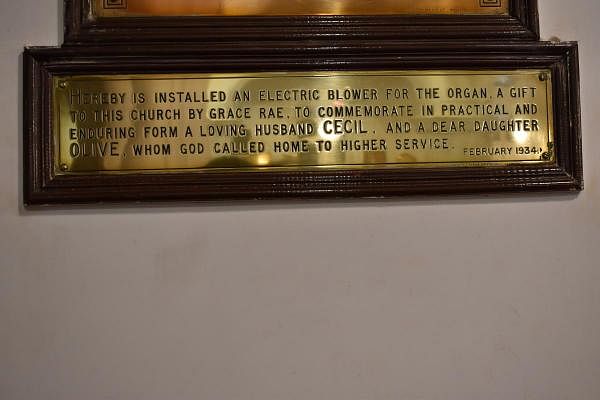Kirk’s Pipes puts ‘toasters’ in awe


Music is an experience that shares a close bond with nature, and so does the pipe organ. The large-scale instrument did not have a grand start but rather in a saloon. Ctesibius, a barber apprentice in ancient Greece, once while adjusting mirrors found that air under pressure in the pipes created sounds. Intrigued, he went on to fix a flute at the ends that in turn produced a melody. And thus the instrument began its journey and to this day claims an important space in the music realm, even after two thousand years of its invention.
At the formative stages, due to inconsistent air pressure, water proved a driving factor, making way for the hydraulus (water organ). But later, the organ builders in medieval Europe, acknowledging its wide use in religious spheres like cathedrals and basilicas, introduced blowers as a revolutionary mechanism to see the organ from being a ‘noisemaker’ to something that could catalyse human senses with an exorbitant quality and pitch. Also, when organs were built on a mammoth size with exotic designs, they found popularity in secular circles like operas and orchestras.
Every religion contains some amount of mystery. So, the organ in the hands of a good musician can evoke that.
India, specifically Bengaluru was home to the British for quite a few centuries, and to meet the spiritual welfare of the masses, they built magnificent churches, and one of them was St Andrew’s Church in 1866 (called the Kirk) on Cubbon Road.
Overlooking the South Parade ground, it attracts visitors through its magnificent gothic structure, adorning stain glass and most of all, its elegantly designed
massive pipe organ.
Today, the cost of a pipe organ is Rs 70 to 80 lakh; then, one might not find a ray of daylight in the passion that St Andrew’s had for music when it took an expensive endeavour of that sort within a stint of its establishment.
A beautiful organ was built at a cost of £ 2500 by the celebrated Peter Gonacher & Co., Huddersfield, England, and was subsequently installed by Jupe on May 3, 1881, with W R Cox to be the first organist to play on it. The organ is a replica of St Andrew’s Kirk, Chennai.
Any visitor to St Andrew’s might buy into a lie that the massive sound is created by a few rank of metal pipes sitting on the facade, but there are over a thousand pipes lurking inside ranging from the size of a pencil to a lamppost. The facade comprises the Great pipes, spiking above them form the Swell pipes controlled by a Pedal below the Console, on which the organist plays the instrument, flanked by Stops.
A brass plaque fixed by the organ speaks the effort of Cecil Rae gifting a motor blower in memory of her husband in 1933, which breathed a new tonal quality. A wooden treadle still remains as a souvenir attached on the hip of the organ.
Joshi Mark, Secretary, says “The enormous, bell-clear Pipe organ at St Andrew’s received laudable remarks from members of St Mark’s Church when they had to worship at St Andrew’s as a result of a fire accident in 1923. Moreover, we are grateful for the strong commitment of our predecessors for painstakingly maintaining the organ in mint condition, and we hope that our posterity would follow their footprints.”
Restitutive ambassadors
St Andrew’s boasts of a cavalcade of distinguished organists like D S Anderson, Edmonds, E H Fewkes, Bryan A Moore, Handel Manuel, J T William Joseph, Rohit S Silus, Andrew Bhagyanathan and others who expressed sheer dedication in not just playing the instrument, but also maintaining it.
Andrew, the incumbent organist, says “Every Presbyterian Church has a tradition of having a pipe organ, and St Andrew’s at Bengaluru is among them.” He recalls Randall Giles (Episcopal Church of America) while on his music exchange to St Andrew’s suggested Christopher Gray for the restoration work.
On invitation in 2008, Christopher Gray, M/s Middle Organ Co, UK, says Andrew undertook the restoration work with a commitment to enhancing its acoustics by adding four new stops (Clarinet, Twelfth, Clarion and Mixture). This music physics made way for adding 500 new pipes which had the power of even pull the attention of a wayfarer walking on the bustling Cubbon Road.
Vijay Upadhyaya, Director, Vienna University choir, marks the organ’s acoustics, which has a fantastic resonance and presence. It has unparalleled tonal balance and quality, which makes it superior to the electronic ones.
He adds that Richard Marlow, Professor, Trinity College, Cambridge on his visit to St Andrew’s was surprised by the vibrant energy of the organ while playing the stops individually.
The cliches that strip the pipe organ off its artistic merit are horror movies, say aged musicians sitting in reclusive spaces playing old hymns, but St Andrew’s is different as it made the instrument venture into music genres through its fledgling musicians under able peers. The church, every last Sunday of the month, hosts recitals, concerts where music enthusiasts are invited across different verticals to perform.
The window has indeed opened up people to not just perform but also help each other in expanding their knowledge base. St Andrew’s music legacy is on a mission of making youngsters as ‘creators’ of music than merely being ‘consumers’.
Deccan Herald is on WhatsApp Channels| Join now for Breaking News & Editor's Picks